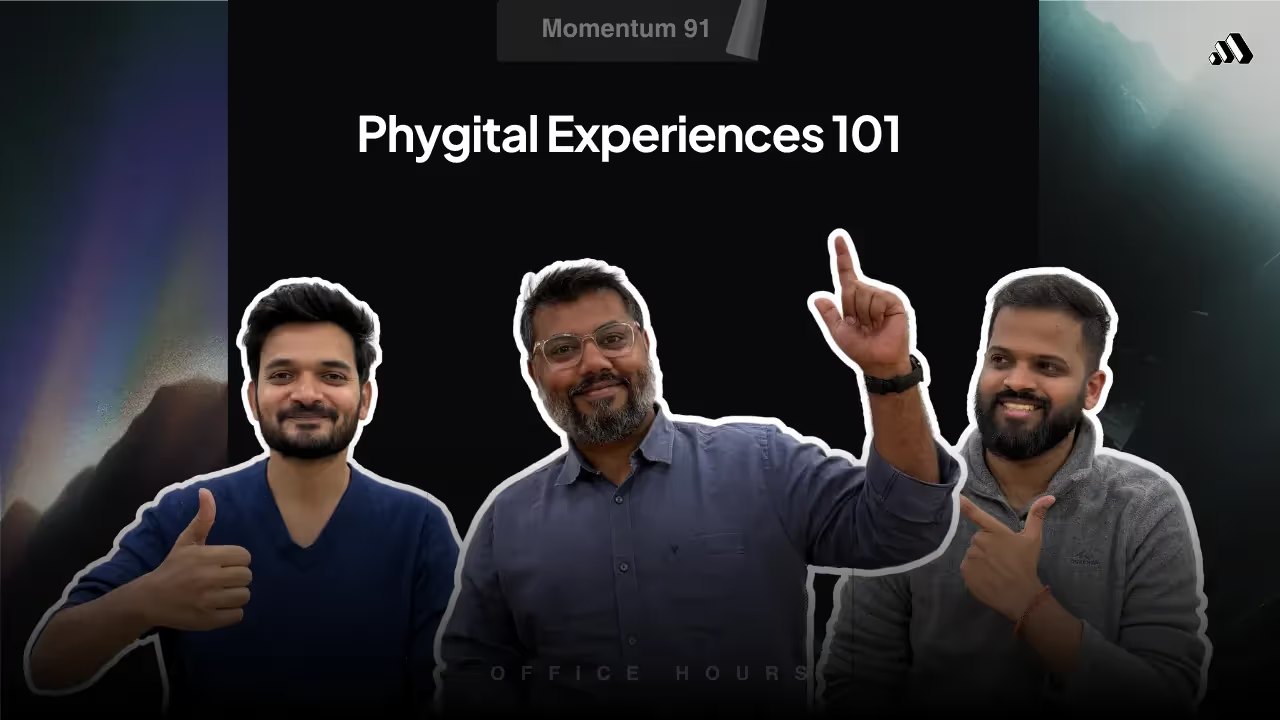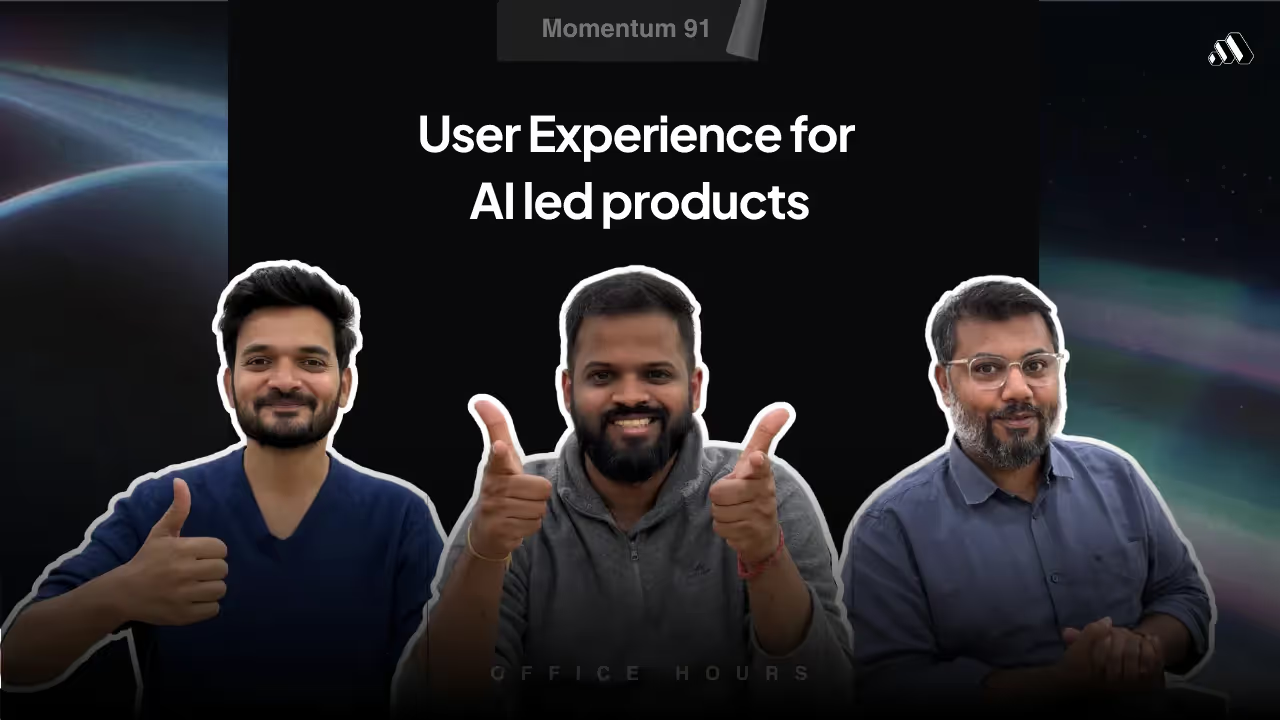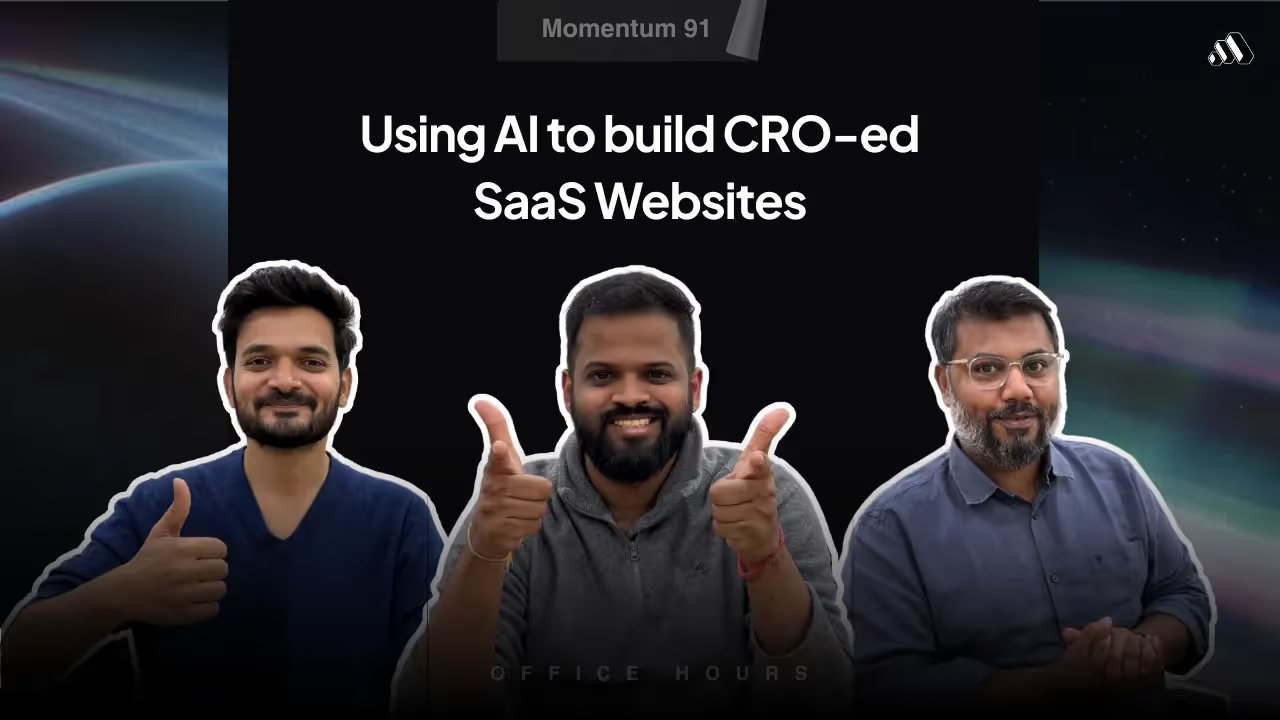Pricing Strategies for SaaS firms
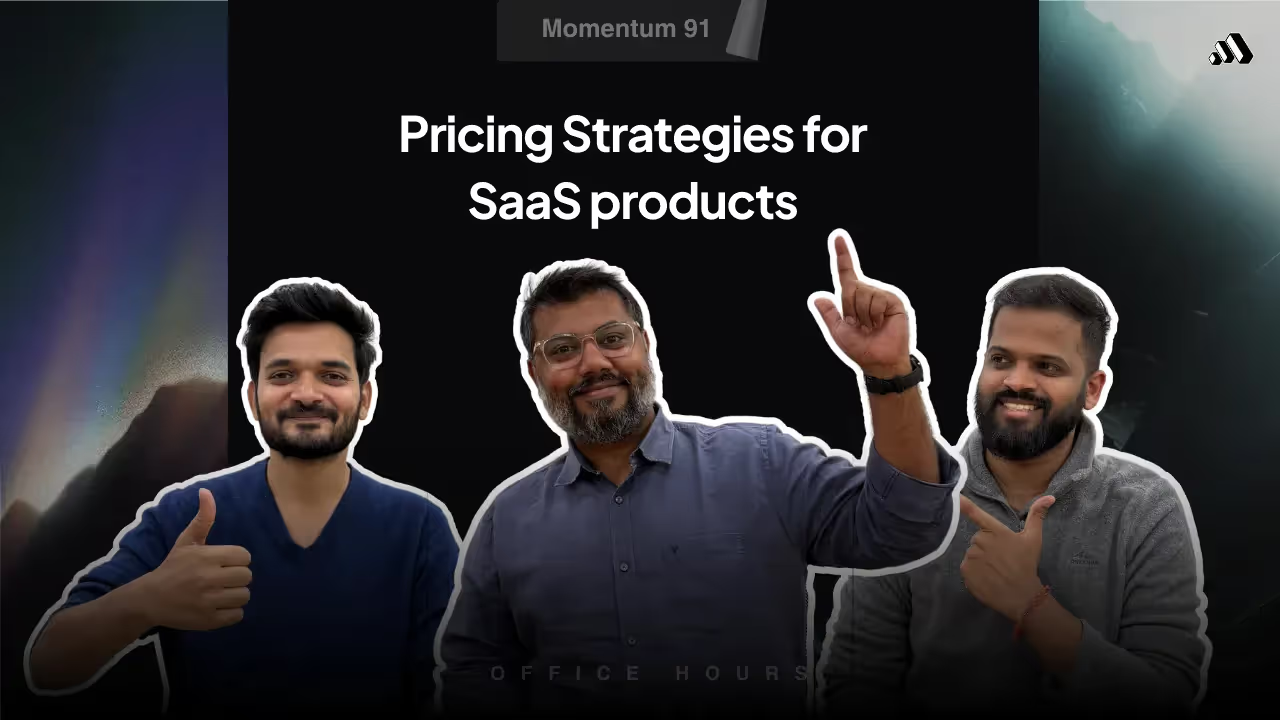
Introduction
In this conversation, the co-founders of Momentum91 discuss various pricing strategies for SaaS products. They explore the evolution of SaaS, different pricing models, the importance of balancing value with pricing, and how to design an effective pricing page. The discussion also covers feature allocation across pricing plans, managing changes in pricing, and the debate between freemium and free trial models. The insights provided aim to help SaaS companies optimize their pricing strategies for better customer engagement and revenue generation.
Key Takeaways:
- SaaS pricing strategies should be actionable and practical.
- Understanding the evolution of SaaS helps in pricing decisions.
- There are four primary pricing models for SaaS: per user, usage-based, feature-based, and flat fee.
- Balancing the value provided to customers with the pricing is crucial.
- A simple pricing page design enhances user experience and decision-making.
- Feature allocation should consider the maturity and needs of the target market.
- Grandfathering pricing can help retain early adopters when changing features.
- Freemium models can attract users, but charging for the product is often more sustainable.
- Pricing should reflect the value delivered to the customer.
- Iterative testing and adjustments are key to finding the right pricing strategy.
Transcript
Yash Shah (00:00)
Okay, shows that we are live.
Let's wait for a couple of people to join in.
So why are we so silent? Someone else say something. Confirming if we went live already. No, we are live. live. Yeah, we got viewers. So go ahead. We'll be notified as well. Yeah, we are live. Awesome. So let's start. Hello and welcome to Momentum Officers. My name is Yash, and I'm joined by my co-founders Harsh, Jay, and Kaushik to discuss topic of the week, which is pricing strategies for SaaS funds.
Our goal is to provide you with actionable insights and practical strategies that you can apply to your own products. Throughout the session, we encourage you to engage with us by asking questions and sharing your thoughts. This is a fantastic opportunity to learn from each other and give you insights that can help drive your SaaS initiatives forward. So let's get started. Jai, Harsh, Kaushik, how are we doing today? Yes, doing great today. Thank
Early Diwali celebrations, we had an office party or something like that today, right? am not aware of what happened because I was in a few calls. Yeah, we have played one game. There was a game that we were playing and everything. Did we win? Did someone win? Yeah, Perfect. Team of winners.
So we are going to talk about pricing strategies for SaaS phones. Let's get started. Yes. So Yash, before we go into the strategies of pricing for SaaS, if you could have a little idea with respect to what are the set of pricing models that typically SaaS companies use, would be helpful. So can you share some of those? Sure. So there are a couple of ways in which a SaaS can be priced.
And so, before we get into that, let me share with you how did we get here. So, before Software as a Service came around, we were building essentially custom software for each and every business and each and every problem that needed to be solved. And that, I I do not have to share where it is an extremely inefficient and expensive way of solving business problems because everyone was solving their problems in cycles. And then some,
bright minds sort of figured out that hey, know, I'm solving, I'm building 10 things to solve a problem here and building another 10 things to solve a problem there. However, eight out of those 10 things are same in solving both the problems for different companies. So why don't I build a software that sort of is, you know, the common eight things are part of that software and then just offer it as a service, right? Offer it as a subscription.
for a very small fee. And that's essentially how SaaS was born. Today, what we call a SaaS is everything and everything that is hosted on the cloud and is being consumed as a service by an individual. It could be for free or for paid. So WhatsApp is a SaaS. Netflix is also a SaaS company. All of these are essentially softwares that are offering
or being consumed as a service and they solve one or the other problem that we face in our life. Gmail is also a SaaS and so on and so forth. There are four ways of pricing a software. So one is that you can cap in terms of, and we're going to talk about primarily B2B SaaS, so business to business SaaS. And so you have four ways of pricing a SaaS product. So first is you can cap on the number of users.
So, you you can sell on per seat or per license. And so that's, you will see how, let's say as an example, Google Apps for Work or Office 365 by Microsoft, these are per user per month, per user per annum sort of price. Second, you can price on usage. So, does not matter how many users are having the access to it. But up until how much are they utilizing
the software. So, in that you will see, you one of the biggest examples is OpenAI, OpenAI B2B, right, not B2C, B2C is still user based pricing. So, I am paying for myself, but B2B OpenAI, which is where I have credits and things like that, but depending on how many credits or tokens do I utilize, I have to pay OpenAI. The third way of charging is for different features, which is where I saying that,
If you pay a certain amount, I am going to give you 5 features or 7 features. If you pay a little more, then I am going to give you access to 3 additional features and so on and so forth. And then the fourth way of charging which is not popular, but the fourth way of charging is just having a flat fee, flat access fee. And so the only popular example of that is Basecamp.
There are very few softwares that are examples of this. But with Basecamp, you pay $99 a month. And then whether you are IBM or you are Momentum or you are a startup or you an enterprise or you are a whatever you are, you pay $99 a month and then you have license to do anything. So these are the four major ways of charging, right? For users or licenses, for usage or credits or tokens, for features and a flat.
time bound sort of a fee. Yeah, yeah. So, so in any pricing model, right, so the main goal will be like the amount that our customer are giving to us, right? And against them the value that we are giving to customer, right? So there must be some ratio, right? There must be equality, right? So is there how do you measure or we can say how what are the data points that help us to
identify the pricing that we have set for my product, right? And the customer they are giving to us. They are equally balanced. How are their data points or any measurement that help us to do that? Any pricing models, not any particular. Yeah. Sure. So I'll tell you what, Sir. So we're only talking about B2B SaaS. It will be extremely complicated if we were to talk about B2C because for consumers,
there are a lot more things that can be sold than to businesses. So to an individual or to a consumer or customer, if you're not a company, then I can sell a lot of things. So can sell pride, can sell ambition, I can sell success, I can sell fear, I can sell all of those things. And that's a much more complicated world. But if you are selling, if you're a business that is selling to other businesses, you can.
more likely sell either of these three things. So you are either helping them save time, save money or helping them make more money. These are the primarily three things that you are selling as a B2B SaaS company. And earlier what I shared the four things, they are pricing models. But from a pricing strategy standpoint, you can largely either have a cost based pricing or a value based
So, cost based pricing is cost plus, right? So, which is how much does it cost me to make it and then I will add a premium to it and then I will sell it. And the amount of premium that I add, it depends on how desperate am I to close a deal? How much do I want to enter a new market? How much do I want to enter a new industry? How much, like at what stage is my company?
However, value based pricing on the other side, essentially we try and figure out that if you have access to this software, then what is the amount of value that you will be able to drive in terms of cost savings, money savings or increase in income. And that value, whatever that I am able to figure out that this is the value that it will drive for you, I will then put a percentage to that. And okay, this percentage of the value that I create for you, I will charge as a
as my fee. That's how ideally it should work. But it's extremely difficult to figure out how much value will I drive for different businesses because if we just take this streaming software, the streaming software will have different amount of value for different businesses and will have different amount of value for different size and scale of audience also. So if I have 1,000 live viewers versus if I have 15,000 live viewers,
It will drive extremely different amount of value, while the functionality largely stays the same. And the whole game behind identifying the right pricing for your SaaS is to figure out what is that sweet spot where even if I have, let's say, 1,000 people who are watching this live, it's still a great deal for me. If I have 15,000 people watching this live, it's still a great deal for me. That's essentially how you would arrive at your pricing strategy.
OK, yeah. Yes, so that brings me to one question, since you spoke about different models that exist, is that the first thing that comes in is how should one go about designing their pricing page in their website? I think that is because that's the first thing that a potential user would be looking at. So what strategies should one have within the design of the pricing page layout and things to be included?
Great question. So, essentially, a good way to think about it is that if a visitor is looking at your pricing page, that means that you answered some questions that they had or you've given them some hope that this is something that the problem that you solving is important enough for them and they believe that you might have the solution to it. In their mind, they already know
what is the loss that they are bearing today because of that problem not being solved. So we'll take an example. So let's take an example of a sales CRM. So let's say we're using spreadsheets to manage all of our leads or DUs and contacts and stuff like that. When I'm looking at HubSpot as an example, I already have some idea in my mind as to how much sale am I losing or how many of my workflows are not.
optimized enough or some deals are falling through the cracks, some follow ups I not able to do one time. So, already have an idea and the HubSpot homepage or whatever the landing page that I was on has given me some amount of hope that my problem could be solved, my problem might get solved. So, then I clicking on the pricing page to figure out what is the investment that I need to make not just in terms of money but also in terms of time to figure out.
whether this will be able to solve my problem or not. That is the thought process and the mind space with which I am clicking on the pricing page and landing on it. So, the first thing that I strongly recommend is do not have a complicated pricing. You can, the better you are with spreadsheets, the more complicated pricing you would be able to create. But please do not do that. Have, like if you just starting out, just have one, maximum two plans.
Every new plan that you create, there has to be a compelling reason as to why you are doing that. Because you will have to handle and manage that complexity in terms of creating those as separate plans in your stripe and then also explaining to people and then also creating your upgrade and downgrade journeys and also have variants with annual, monthly, quarterly and so on and so forth. So, as soon as you introduce one additional plan, you are basically creating three or four different variants.
and then managing and maintaining their upgrade and upgrade juries. So, one thing that I would say is keep it extremely simple. The second thing that and allow them to figure out and create their bucket. So, if it is per user, if it is amount of emails that I can send, if it is usage based or whatever it is, give me tools that I can play with and I will be able to figure out what exactly am I required to pay. The second thing that I would say is if
you are, and a lot of SaaS companies do this, if you are sort of a combination of two or three different platforms, so as an example Notion, so Notion brings together capabilities of Airtable, ClickUp, Asana, couple more, right? So if you are a similar sort of a company, then very clearly highlight that if I am not using your software, then how many different subscriptions will I have to pay?
And the more different subscriptions that I have to pay, it's not just about the higher money that I have to pay, but it is also about training the people on three different softwares and bring like integrating all the three of them in one place and stuff like that. So if you are one of those softwares which reduces or removes the need of using multiple softwares, then highlight that piece really well as well. The third thing that I would say is I'm sure on the homepage or the landing page for the
that you've created, you build some amount of trust through badges and things like that. Pricing page is another opportunity for you to establish a little more trust through ROI based conversations. So highlight how quickly were your existing customers able to generate return on their investment into this tool or platform. Then you should also have frequently asked questions. So some questions that people will have when they are on your pricing page.
you know, how many day trial do you have? Will they be able to switch between plans? Will they be able to move between the limits that you're offering and things like that? And a couple of call to actions at different places that are strategically placed. So these things I would say is 80 % of most pricing pages. And then the last thing here, the last thing is that if you have a lot of line items and sub line items, then have a separate section, right? So your first pricing for just as
two plans, which is where you mentioned in bulleted list, what are the major features that you offer, but then have a like in a section, a couple of codes below have a section where you have a detailed pricing comparison, where then you have the opportunity to have one category and then a couple of line items, another category and a couple of line items and so on and so forth. So this I think is about 80 % of most pricing phases.
So yeah, so yeah, so yes, as you told, we need in the SaaS firm has to keep their pricing model simple, right, but that much complex. So in some of the cases, just to say there are two plans, okay, then you can say the basic and the pro, right. And if you can say that after the one year, we need to introduce the platinum plan.
So, so in each plan, we need to decide some features. I guess these features we can add into the basic plan. These features need to be in program. So how can we decide for these features should include it in which plan? I know it can be very from business to business, right? But still there are some, we can say some strategy that we can keep in mind during the selection of feature respected to the plan hierarchy. So, so more often than not,
When you are building your SaaS, you would have done the exercise of creating your ideal clients and like ideal client persona. And what you would realize is that the reason why you have multiple pricing plans is because within those ICP definitions that you also have, there are micro markets for whom you design those plans. As an example for very small early stage company who just want to get started.
with let's say a sales CRM. And so there if they're moving away from a spreadsheet and moving into a CRM, then they are not going to need extreme high level of automation workflows, while they're just getting started. If they have two or three people, they're not going to require playbooks, they are not going to require a lot of things because they're in very, very early stage of their journey of starting to use a sales CRM.
And then as and when they mature, as and when they also grow, they will have, they will move from one micro market in an ICP to another micro market within the same ICP. And then they require certain set of features and they will grow more and they will require a certain more set of features. So the first plan is essentially designed to make an argument that moving from spreadsheet to a sales CRM,
you have to pay $9 per user per month or $15 per user per month, which is not a lot. But then you have, you know, 10 other advantages. But at the same time, it's not so complicated that you have access to all the features that you are going to get lost and not use it properly. However, once I become mature, then I can have some more features and once I become mature, I can have some more features. And then at that point of time, I could be paying as high as $150 per user per month because
I have matured enough in our journey that I'll be able to get $1,500 per user per month of value out of $150 per user per month license. So that is the first strategy, the first way to go about it, that design each of your plan as per the micro market that you have. The second thing that I would say is, is the higher the plans that you have, you want to make sure that you are any feature.
that will very explicitly save time you want to have on higher plans. You definitely don't want to have in the first plan. So if I as a user or an organization or a team member, and who's a prospect or a customer for you, if I am extremely finicky or extremely paranoid about how do I invest my time, then I should not be on the first
or the smallest plan that you have, then I should be on the second or the third. So stuff like automations as an example, anything that helps me save my time should be on the second or the third plan. That's a good way to make me realize and pay a premium for the direct amount of time that your software is going to save. And don't just think of one person. So if I have 20 salespeople, then automation for 20 salespeople
for 50 leads per salesperson per day, look at the amount of impact that it can generate. So that's the second strategy of, and this is how you will see Pipe Drive and HubSpot and all of their pricing are accordingly. The third way to think about it is apart from the journey upon which the customer is in or apart from the value that the customer is perceiving or believing.
The third way to go about it is depending on the size of the company. as an example, Airtable is a great example. where they say, depending on if you're an enterprise, they know for a fact that you will need certain things. You will need software compliance. You will need SLAs. You will need uptime guarantees. You will need account managers and dedicated support and all of these things, which are typically always part of the enterprise. So depending on the size of the company,
depending on the maturity of the company and depending on the journey that the company is on, you'd be able to sort of figure out which feature goes where. I would still argue that there's still more of an iterative process. might sound a little gut feeling, but you have to try something and then you have to see whether it works. If it works, then that's great. If it doesn't, you have to run those experiments.
So sorry, but I have one follow up So like in this iteration process, it can be possible. I have given some features in the basic term. But now I know these features are going to be very well. But now it will be costly for business. So now I want to move this feature to the pro plan. So at that time, how we handle that situation?
because we already have so many users are already using that feature, So, I don't know, what are we can do in this process? So there is this concept called grandfathered pricing. So this process is called grandfathering in. So as an example, is as an organization, is as long as it is not a loss making thing. It's a loss making thing.
giving you access to a particular feature in a plan and then it ends up costing the company more. If it is that case, then shut down the company. But if that's not the case and you just realize that this feature is more valuable and you want to give it in a higher tier, then you basically grandfather the pricing. So, Harsh, if you're an early adopter and you have access to a premium feature in your startup plan as an example.
or a gold feature in a silver plan, you will continue to stay on silver. And for you, that feature will continue to be part of the silver plan for you. But if Jai signs up after the pricing has changed, then Jai will have to subscribe to the gold plan. And you will be made aware by the SaaS company that, hey, since you are an early adopter, since you believed in us very, very early on, and thank you for all of those things. A SaaS company can also
when they are grandfathering the pricing, that's a good time for a SaaS company. So you realize something, right? You realize that a feature that you're offering for a lower price before and a lower tier before has suddenly become more valuable. And so now people are willing to pay more. So you can leverage that. And you can ask your customers to leave honest reviews on G2, honest reviews on Trustpilot, to share about you on social media, to sign up for your referral program, to...
get on a call with your product manager and spend 30 minutes and give feedback on the product. So there are n number of things that you can ask your early adopters to do in exchange of grandfathering them in the pricing because now suddenly Jay who will sign up tomorrow will pay like $49 a month extra to get access to the same feature that Harsh already has in their account. So that's something that you can definitely, it's a great scenario to be
Interesting. I had a very quick question, Yash. When someone was planning to launch this SaaS product, there's always a question whether they should have a freemium model or whether they should have a free trial model. So are there any particular factors to consider on which one to opt for?
would strongly recommend that when I am a fan of Joker and so he said that if you're good at something, never do it for free. I would extremely recommend charging for your SaaS product. So offer a free trial, but then charge for your SaaS product. There should not be any free forever version for sure. I'm sorry, I'm just realizing that that's not the question that you asked, but this is something that is so
I feel so strongly about this and this is so close to my heart because I offered a free forever version for the longest time and we got a lot of people to sign up and that was just a total and complete ridiculous waste of our time because then you're talking to the wrong customers then you're supporting the wrong customers then you are taking the company in the wrong direction and stuff like that happens
This is through no fault of those people. You offered the free forever version and they just signed up. But if you're starting out, a good way to go about it is to have a freemium plan, which is where you're saying, you 14 days, 21 days, 30 days or 7 days free trial and then you've got to commit to a paid version. The only consideration over here is that in very small cases,
you might be existing in an industry where the status quo is a free forever version. So as an example, if I am building a website builder, like Webflow or Squarespace or Bodaddy or Wix, in those industries, there is a free forever version. If I am building, let's say something that is a dock maker,
there is a version of Evernote and Notion and all of them. There is a free forever status quo. And only in those cases, like those very specific cases, you will have to figure something else out. But largely, you should have a pricing from day one and you should always punch above your weight. So whatever you think the pricing should be, just double it. And lose deals because of high pricing. It is okay, right? So...
So, you know, let people say, let people come on call and say that I love their product, but I cannot afford it. Because if they are seeing that, then you always have the opportunity to offer them a discount and keep them in. But let that happen. Don't be under confident and price it low to begin with. And even like free trial will give a faster validation as well, maybe rather than having a free trial.
We have some comments I guess as well.
Yes, cool designer, that is me. I'm not the ex founder of KleinJoy. am, mean a founder is a founder for life. I'm a founder of KleinJoy. KleinJoy we got acquired by a company, but I'm still a founder. I like to call myself as a founder to apply AI for the user system so that I can recommend the best plan or even let the AI calculate new pricing model as you go.
Or create a new affair, absolutely. So cool designer, can try to do that. can basically, like one of the good ways to go about it could be download your mix panel reports and ask Chad, GPD or Claude to analyze and make recommendations on your pricing. You can also alternatively sign up to platforms that are subscription management and analytics software. So sign up to platforms like Bear Metrics or sign up to platforms like Chadmobile.
and get your subscription analytics and ask ChartGPD or Claude to give you an analysis in terms of what are the pricing that you could or pricing changes that you could make. I hope that was helpful. But with that, we have come to the end of the conversation today. I hope this was a valuable conversation that we had today and you were able to get some insights.
and you are able to get some help. If you have not, I have been asked to say this, if you have not subscribed to this channel or followed us wherever you are watching this whether it is on LinkedIn or YouTube, I tell you, I tell you the number one benefit of subscribing today to this channel is that you will not, it will save you the trouble of having to do it in the future.
So just do it today, And subscribe or follow today and just get done with it. But I hope this conversation around SaaS pricing was meaningful and helpful. hoping to see you again next time. Thank you for joining in. And see you again. Bye. Bye.
The inbox update you’ll never want to skip
A quick catch-up with ideas, wins, and tips worth stealing, straight to your inbox every week.
The easiest way to reach us.
Share your details and we’ll get back within 24 hours.
Office hours
A plethora of insights,all in one place
From strategy to execution. All the big ideas, practical guides & fresh perspectives that’ll help you scale with confidence
Ebooks
Comprehensive guides that break down the shifts in business and technology, Helping you lead with clarity.

Office Hours
Your direct line to our experts. Practical advice for scaling, right when you need it.
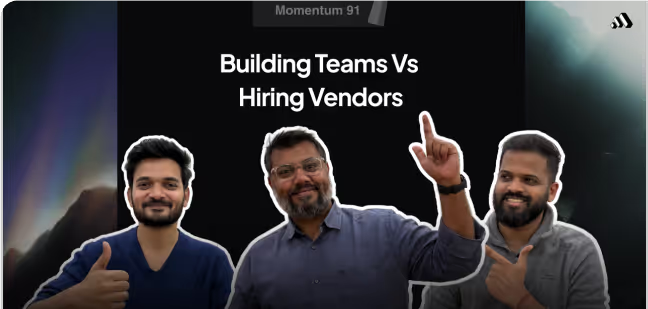
Reports
Data-backed perspectives on where industries are headed, giving you the foresight to make bolder moves.

Newsletter
A quick catch-up with ideas, wins, and tips worth stealing, straight to your inbox every week.
.avif)
Podcasts
Conversations where you get to know everything from the ones who know it best.
.avif)
Your Offshore Development Center, Done Right
Access top-tier global talent, enterprise infrastructure, and complete regulatory compliance through our proven model.
Start Now




